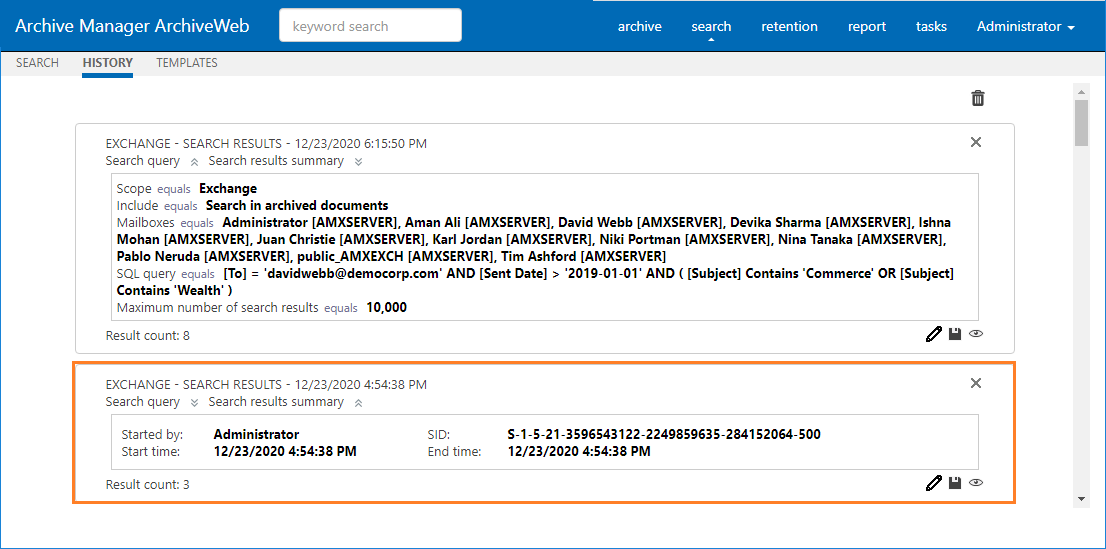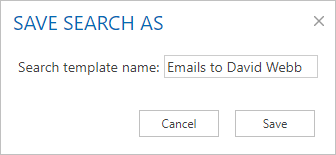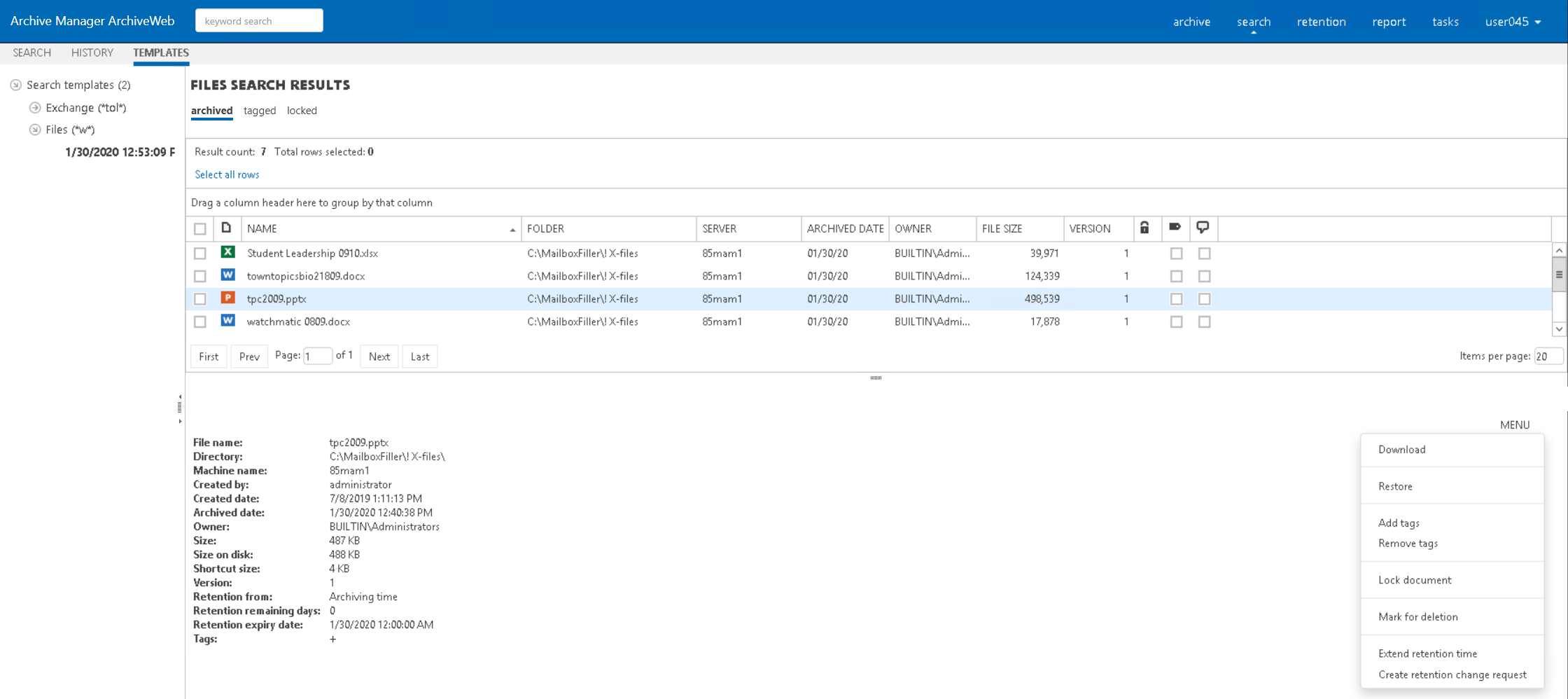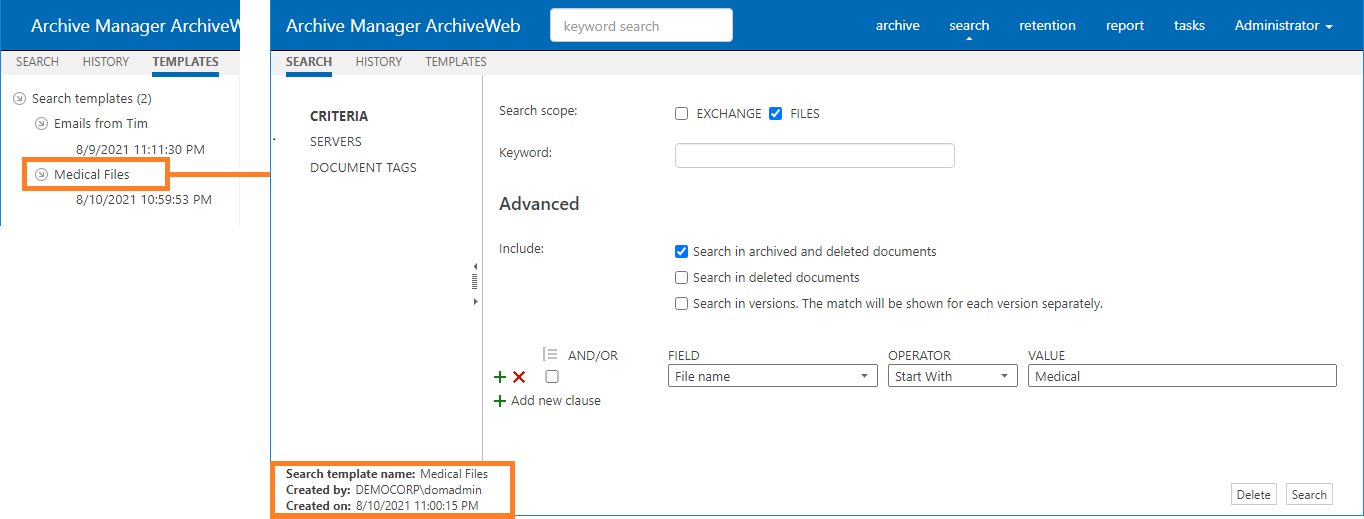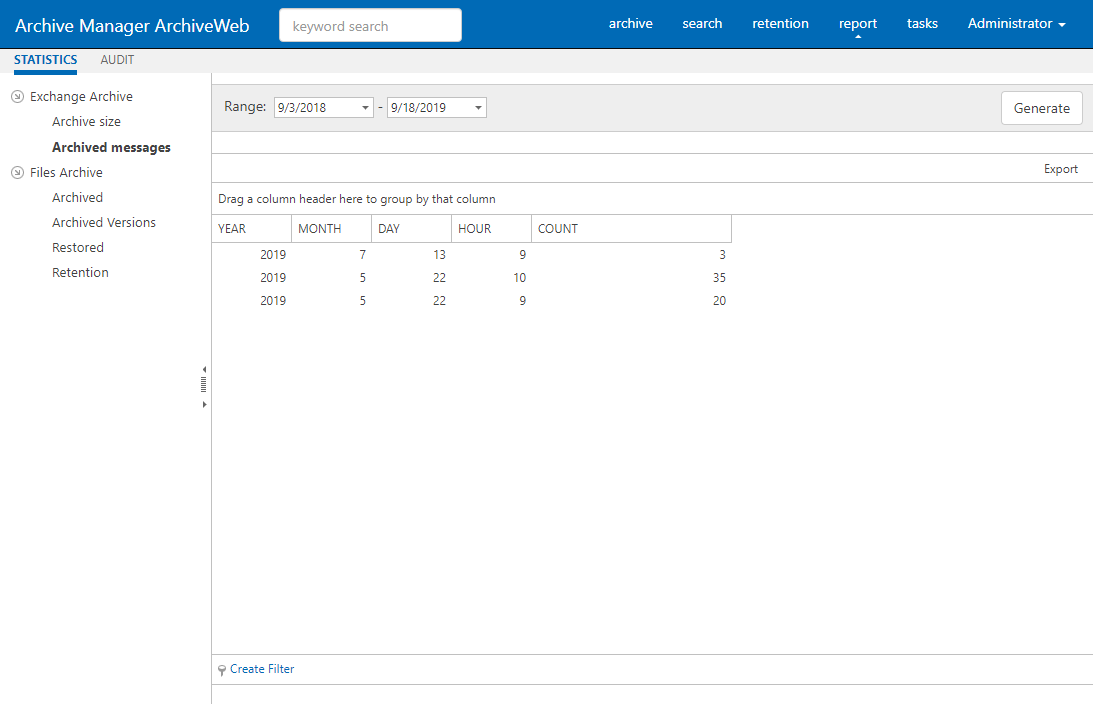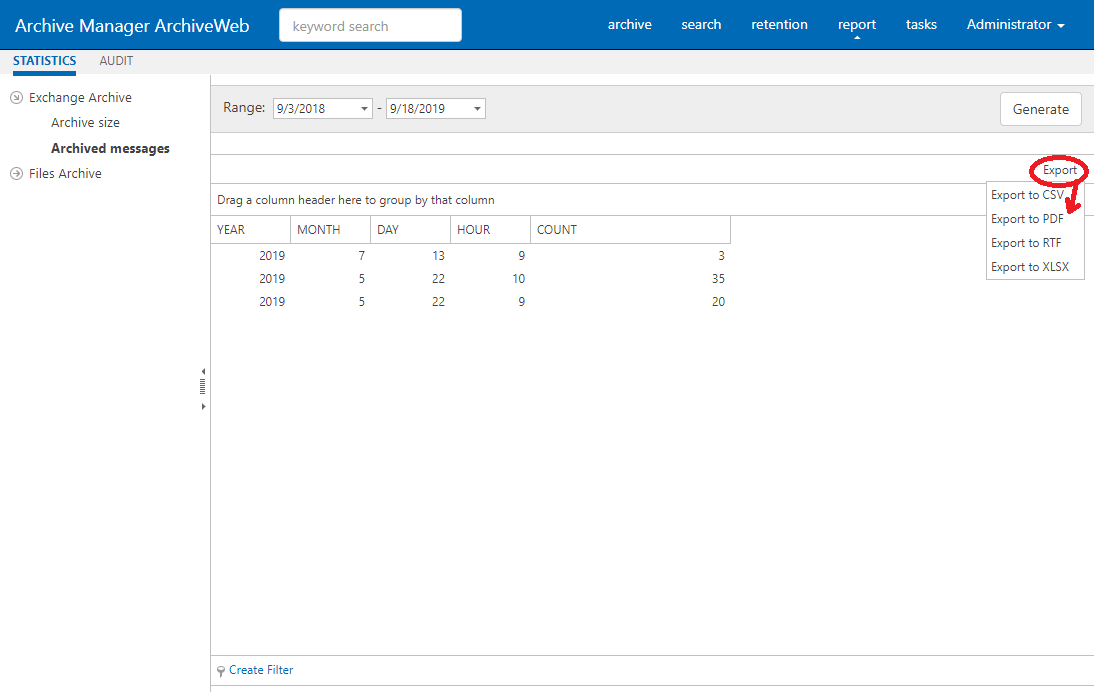Search History
Every search in ArchiveWeb is logged and displayed in the History page. Search history is stored in the search history cache separately for each logged in user who runs a search. Each search history log entry indicates the search type (Exchange, File or Keyword) and the start date and time of the search in the log entry header.
In this topic:
·Viewing the search result summary
Viewing the search result summary
1.Click Search on the main menu and then click History.
2.Click 
The search result summary section presents the following information
a.Started by - username of the person who ran the search.
b.Start time - date and time the search was started.
c.SID - unique search identifier.
d.End time - date and time the search was completed.
3.Click 
1.Click Search on the main menu and then click History.
2.Click 
The search query section presents the following information
a.Scope equals - the application data that is searched.
b.Include equals - the data set within the search scope that is included in the search.
c.Mailbox equals - the mailboxes that are included in the search.
d.SQL Query equals - SQL query that was used to search for archived items.
e.Maximum number of search results equals - the upper limit of the result set that was configured for ArchiveWeb when the search was started.
3.Click 
1.Click Search on the main menu and then click History.
2.Locate the search you want to review.
3.Click 
1.Click Search on the main menu and then click History.
2.Locate the search you want to review.
3.Click 
1.Click Search on the main menu and then click History.
2.Locate the search you want to review.
3.Click 
4.Enter a suitable name in the Search template name field. Then click Save to save the search query as a template.
The search history page displays the last 10 searches by default. To customize the display limit follow the steps described below:
1. Open the C:\Program Files\Quest\MAMSearch\PamSearch.exe.config file.
2.Add a new section name (if it does not exist) under the <configSections> node
|
<?xml version="1.0" encoding="utf-8"?> <configuration> <configSections> . . . <section name="SearchHistory" type="System.Configuration.NameValueFileSectionHandler,System, Version=1.0.3300.0, Culture=neutral, PublicKeyToken=b77a5c561934e089" /> </configSections> |
3.Create a new SearchHistory section (if it does not exist)
|
<?xml version="1.0" encoding="utf-8"?> <configuration> <configSections> . . . <section name="SearchHistory" type="System.Configuration.NameValueFileSectionHandler,System, Version=1.0.3300.0, Culture=neutral, PublicKeyToken=b77a5c561934e089" /> </configSections> <SearchHistory> <add key="maxcount" value="20" /> </SearchHistory> . . . <configuration> |
4.The maxcount value can be any number between 1 and 2147483647. When this key is missing from the PamSearch.exe.config file, the default value 10 is used.
Search history is stored SQLITE files in a cache folder. The default location is C:\Program Files (x86)\Quest\MAMSearch\SearchCache\<userSID>\*.sqlite and the cache is periodically cleaned. To customize the search history cache retention time limit follow the steps described below:
1. Open the C:\Program Files\Quest\MAMSearch\PamSearch.exe.config file.
2.Add a new section name (if it does not exist) under the <configSections> node
|
<?xml version="1.0" encoding="utf-8"?> <configuration> <configSections> . . . <section name="SearchHistory" type="System.Configuration.NameValueFileSectionHandler,System, Version=1.0.3300.0, Culture=neutral, PublicKeyToken=b77a5c561934e089" /> </configSections> |
3.Create a new SearchHistory section (if it does not exist)
|
<?xml version="1.0" encoding="utf-8"?> <configuration> <configSections> . . . <section name="SearchHistory" type="System.Configuration.NameValueFileSectionHandler,System, Version=1.0.3300.0, Culture=neutral, PublicKeyToken=b77a5c561934e089" /> </configSections> <SearchHistory> <add key="timelimit" value="365.23:59:59" /> </SearchHistory> . . . <configuration> |
4.The timelimit format is days.hours:minutes:seconds. For example, the value 365.23:59:59 indicates that the search history entries will be stored for 365 days, 23 hours, 59 minutes and 59 seconds.
Search Templates
When you expand the Search > Templates node, you may see a list of search templates that have been saved so far (search results can be saved from History tab as described in the History section).
Click on the arrow next to the template to expand the template node. Under this node you will see the link to respective search results - with the date and time when they were saved.
Clicking the search results link will display the search results in the main pane. Here you can benefit from the filtering functionality as in all ArchiveWeb lists grouping, filtering by status (tagged, locked etc.) and creating custom filters.
The MENU link in the top right corner of the item detail pane offers additional actions for the selected item:
·Download download the selected item.
·Restore restore the selected archived item to original item.
·Add tags or Remove tags adds or removes a tag from the selected item.
·Lock/Unlock document locks or unlocks selected item.
·Mark for deletion marks the selected item for deletion. The item will be deleted according to the retention category in use.
·Extend retention time increase the time for which the item cannot be deleted from the archive. Setting shorter retention than the actual retention is not supported. After the specified period (in months) the item can be deleted manually or by a Delete job if such is scheduled in respective Enterprise Manager.
·Create retention change request send a request to the approving person for selected item deletion or increased retention time when it can't be deleted from the archive. The Approver who is the person with adequate permission in Archive Manager, will receive the request through email notification if Archive Manager SMTP is properly configured.
Templates handling
When you click on any template name under the Templates node, ArchiveWeb redirects you to the given search criteria page. It can be either Exchange, Files or Common search depending on the template. All search criteria are configured by the template. You can click Search to perform the same search with the search settings specified in this template.
On the screenshot below you can see how the template is displayed once you click its name under the Templates node. The main pane presents the usual Exchange/Files/Common search window. The only difference is the bottom part of the windows. There you see the template metadata (name, user, date of creation etc.) and action buttons:
·Search runs search query
·Delete deletes the template completely from the Templates node
Report
With Report functionality at hand, users have overview of their email and/or file archives. Clear concise information in terms of how many items were archived, when, what is their size original or shortcut etc. Files features also information on retrieved items.
Report section consists of two tabs - Statistics tab with information on archived emails/items and Audit tab with logs of user actions.
Please note that full access to this functionality must be granted to the user under Permissions (see the Roles & Permissions section).
Statistics
This tab was designed to give the administrator fast, reliable and comprehensive information about archived emails/files. The number of emails/files, their size as well as space saved on the disc at archiving all these essential data can be sorted by folder, user or time period. Exporting the statistics is also possible.
Statistics are available for:
oExchange Archive
oFiles Archive
NOTE: Not all Statistics functions may be available for the logged-on user. The user must be granted the necessary permissions. For more information see the Roles and Permissions sections.
Exchange Archive statistics
To generate the Archive Manager for Exchange statistics click on the Report from the main menu bar. Then form the grey sub-bar click Statistics and unfold the Exchange Archive node. Then select whether you want to display statistics for:
·Archived messages (count of messages) or
·Archived size (size of original message; shortcut size etc.)
NOTE: Date range selection is also possible (to improve performance). The statistics can be generated also in Archive Manager for Exchange Enterprise Manager.
Files Archive statistics
To generate the Archive Manager for Files statistics click on the Report from the main menu bar. Then form the gray sub-bar click Statistics and unfold the Files Archive node. Then select whether you want to display statistics for:
·Archived (details on archived files) or
·Restored (detailed on restored files)
·Archived versions (details on files with versions in the archive)
·Retention (details on files whose retention ends at the listed date) - a new column Retention remaining days and pagination have been added
NOTE: The statistics can be generated also in Archive Manager for Files Enterprise Manager.
Statistics table functions are similar to ArchiveWeb table functions:
ØChange the column sorting order by selecting the given column header and clicking its down/up arrow on the right (in case the arrow is not visible adjust the width of the column by dragging the line)
ØGroup table data by any column. To do so, drag the column header to the bar right above the table. Generated groups can be expanded by clicking the arrows next to them. As usual, the sorting order can be changed by clicking the little arrow in the dragged column header.
To export the data, click Export at the top-right of the table. The Export menu opens and you can choose to export the statistics to Excel, CSV, PDF or RTF.

